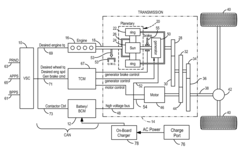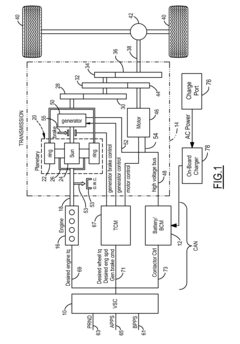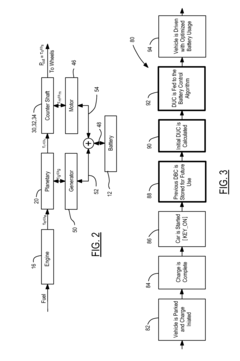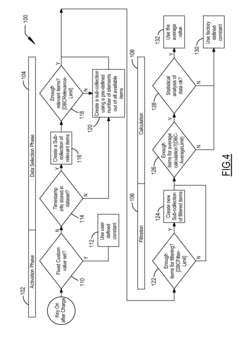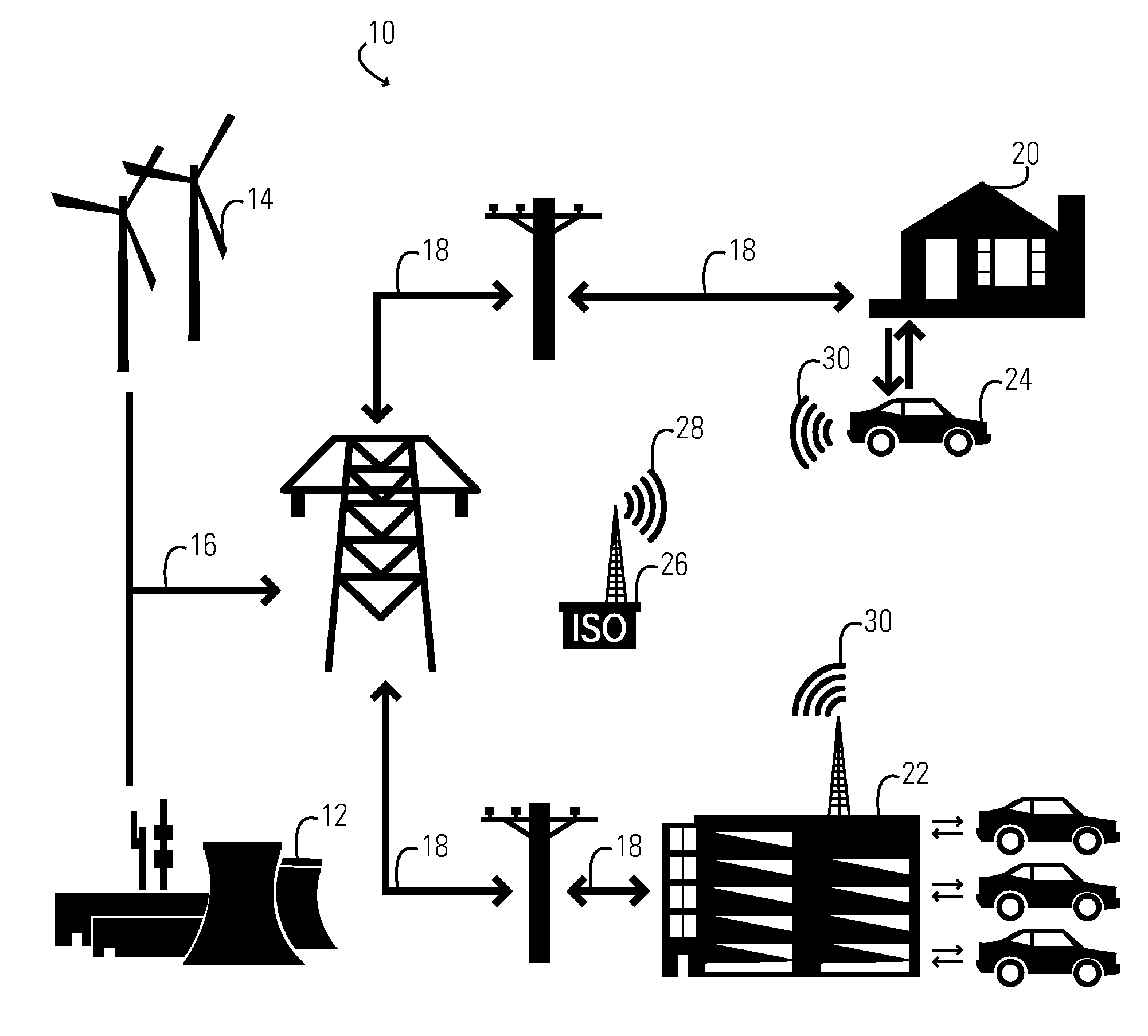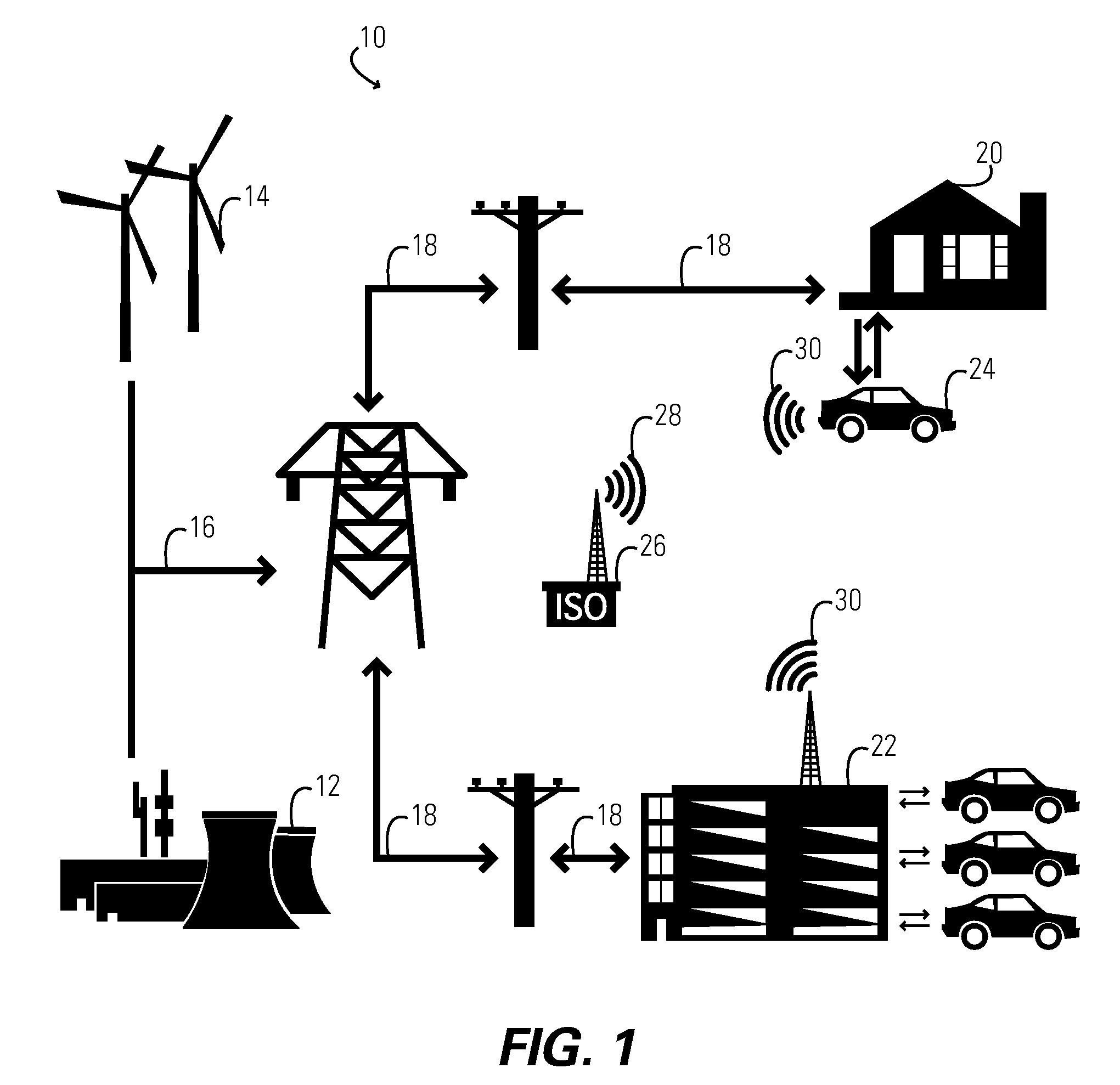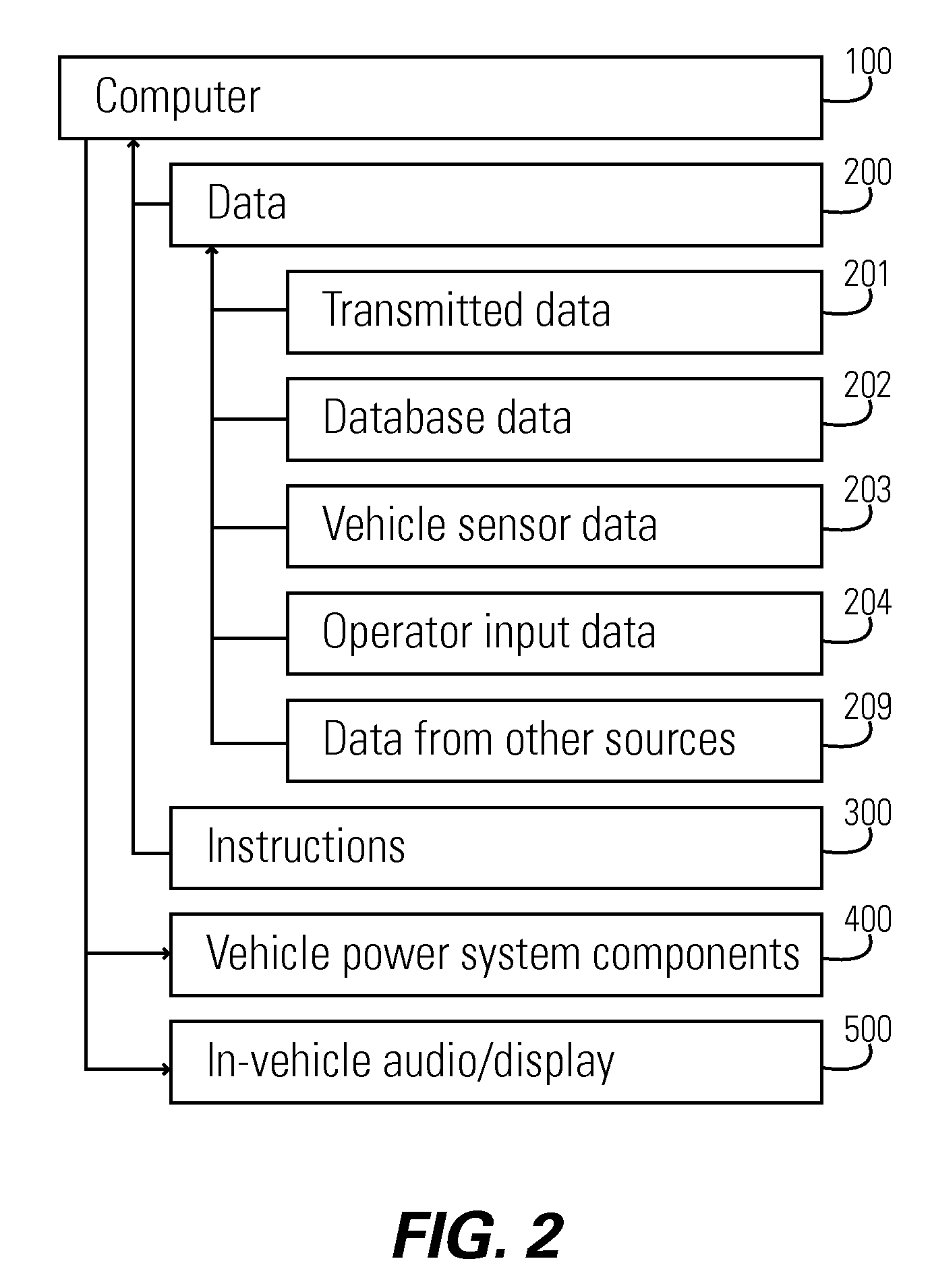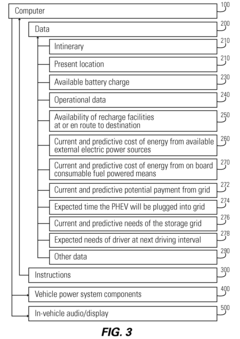How PHEV supports aging electrical grid infrastructure
AUG 14, 20259 MIN READ
Generate Your Research Report Instantly with AI Agent
Patsnap Eureka helps you evaluate technical feasibility & market potential.
PHEV and Grid Evolution
The evolution of Plug-in Hybrid Electric Vehicles (PHEVs) and the electrical grid has been a symbiotic journey, with each influencing and supporting the development of the other. This relationship has become increasingly important as aging grid infrastructure faces new challenges in the modern energy landscape.
PHEVs emerged as a bridge technology between conventional internal combustion engine vehicles and fully electric vehicles. Their ability to operate on both electricity and gasoline provided a flexible solution for consumers, while also offering potential benefits to the grid. As PHEV technology advanced, so did the possibilities for grid interaction.
The concept of Vehicle-to-Grid (V2G) technology marked a significant milestone in this co-evolution. V2G allows PHEVs to not only draw power from the grid but also feed it back when needed. This bidirectional flow of energy opened up new possibilities for grid support and stability, particularly in areas with aging infrastructure.
As the penetration of PHEVs increased, utilities and grid operators began to recognize their potential as distributed energy resources. The aggregate battery capacity of a fleet of PHEVs could act as a virtual power plant, providing services such as peak shaving, frequency regulation, and voltage support. These capabilities became increasingly valuable as the grid faced challenges from intermittent renewable energy sources and growing demand.
The development of smart charging technologies further enhanced the synergy between PHEVs and the grid. Intelligent charging systems could optimize charging times based on grid conditions, energy prices, and user preferences. This helped to balance load and reduce strain on aging infrastructure during peak demand periods.
Grid operators also began implementing demand response programs that incentivized PHEV owners to participate in grid support activities. By adjusting charging patterns or allowing their vehicles to discharge power back to the grid during critical periods, PHEV owners could contribute to grid stability while potentially earning rewards.
As the grid infrastructure continued to age, PHEVs emerged as a potential solution to defer or reduce the need for costly upgrades. By strategically deploying charging infrastructure and leveraging the flexibility of PHEVs, utilities could better manage local grid constraints and extend the life of existing assets.
The integration of PHEVs into the grid ecosystem also drove advancements in communication and control technologies. Standards for vehicle-grid interaction were developed, enabling seamless communication between vehicles, charging stations, and grid operators. This infrastructure laid the groundwork for more sophisticated grid management strategies and paved the way for future innovations in electric mobility and smart grid technologies.
PHEVs emerged as a bridge technology between conventional internal combustion engine vehicles and fully electric vehicles. Their ability to operate on both electricity and gasoline provided a flexible solution for consumers, while also offering potential benefits to the grid. As PHEV technology advanced, so did the possibilities for grid interaction.
The concept of Vehicle-to-Grid (V2G) technology marked a significant milestone in this co-evolution. V2G allows PHEVs to not only draw power from the grid but also feed it back when needed. This bidirectional flow of energy opened up new possibilities for grid support and stability, particularly in areas with aging infrastructure.
As the penetration of PHEVs increased, utilities and grid operators began to recognize their potential as distributed energy resources. The aggregate battery capacity of a fleet of PHEVs could act as a virtual power plant, providing services such as peak shaving, frequency regulation, and voltage support. These capabilities became increasingly valuable as the grid faced challenges from intermittent renewable energy sources and growing demand.
The development of smart charging technologies further enhanced the synergy between PHEVs and the grid. Intelligent charging systems could optimize charging times based on grid conditions, energy prices, and user preferences. This helped to balance load and reduce strain on aging infrastructure during peak demand periods.
Grid operators also began implementing demand response programs that incentivized PHEV owners to participate in grid support activities. By adjusting charging patterns or allowing their vehicles to discharge power back to the grid during critical periods, PHEV owners could contribute to grid stability while potentially earning rewards.
As the grid infrastructure continued to age, PHEVs emerged as a potential solution to defer or reduce the need for costly upgrades. By strategically deploying charging infrastructure and leveraging the flexibility of PHEVs, utilities could better manage local grid constraints and extend the life of existing assets.
The integration of PHEVs into the grid ecosystem also drove advancements in communication and control technologies. Standards for vehicle-grid interaction were developed, enabling seamless communication between vehicles, charging stations, and grid operators. This infrastructure laid the groundwork for more sophisticated grid management strategies and paved the way for future innovations in electric mobility and smart grid technologies.
Grid Support Market Analysis
The market for grid support services provided by Plug-in Hybrid Electric Vehicles (PHEVs) is experiencing significant growth as aging electrical infrastructure faces increasing challenges. This market is driven by the need to enhance grid stability, manage peak demand, and integrate renewable energy sources more effectively. PHEVs, with their ability to both consume and supply electricity, are emerging as valuable assets in grid support strategies.
The global market for vehicle-to-grid (V2G) technology, which includes PHEV grid support capabilities, is projected to expand rapidly in the coming years. This growth is fueled by increasing adoption of electric vehicles, advancements in bidirectional charging technology, and supportive government policies aimed at modernizing power grids.
In regions with aging grid infrastructure, such as parts of North America and Europe, the demand for PHEV grid support services is particularly strong. Utilities and grid operators are increasingly recognizing the potential of PHEVs to provide ancillary services, including frequency regulation, voltage support, and load balancing. These services can help defer costly grid upgrades and improve overall system reliability.
The market for PHEV grid support is closely tied to the broader electric vehicle market, which has seen substantial growth in recent years. As PHEV adoption increases, the potential for grid support services expands proportionally. This creates a positive feedback loop, where the value proposition of PHEVs is enhanced by their ability to contribute to grid stability, potentially accelerating their adoption further.
Several key factors are driving the market for PHEV grid support. First, the increasing penetration of intermittent renewable energy sources, such as wind and solar, creates a need for flexible grid resources that can quickly respond to supply fluctuations. PHEVs can help smooth out these variations by providing or absorbing power as needed. Second, the growing strain on aging grid infrastructure, particularly during peak demand periods, necessitates innovative solutions to manage load. PHEVs offer a distributed approach to load management that can alleviate pressure on critical grid components.
However, the market also faces challenges. The development of standardized communication protocols and integration of PHEVs into existing grid management systems are ongoing processes. Additionally, regulatory frameworks in many regions are still evolving to accommodate and incentivize vehicle-to-grid services. Despite these hurdles, the potential benefits of PHEV grid support are driving continued investment and innovation in this space.
As the market matures, new business models are emerging. These include aggregator services that pool multiple PHEVs to provide more substantial grid support, as well as innovative tariff structures that incentivize PHEV owners to participate in grid support programs. The success of these models will play a crucial role in shaping the future of the PHEV grid support market and its contribution to addressing the challenges of aging electrical infrastructure.
The global market for vehicle-to-grid (V2G) technology, which includes PHEV grid support capabilities, is projected to expand rapidly in the coming years. This growth is fueled by increasing adoption of electric vehicles, advancements in bidirectional charging technology, and supportive government policies aimed at modernizing power grids.
In regions with aging grid infrastructure, such as parts of North America and Europe, the demand for PHEV grid support services is particularly strong. Utilities and grid operators are increasingly recognizing the potential of PHEVs to provide ancillary services, including frequency regulation, voltage support, and load balancing. These services can help defer costly grid upgrades and improve overall system reliability.
The market for PHEV grid support is closely tied to the broader electric vehicle market, which has seen substantial growth in recent years. As PHEV adoption increases, the potential for grid support services expands proportionally. This creates a positive feedback loop, where the value proposition of PHEVs is enhanced by their ability to contribute to grid stability, potentially accelerating their adoption further.
Several key factors are driving the market for PHEV grid support. First, the increasing penetration of intermittent renewable energy sources, such as wind and solar, creates a need for flexible grid resources that can quickly respond to supply fluctuations. PHEVs can help smooth out these variations by providing or absorbing power as needed. Second, the growing strain on aging grid infrastructure, particularly during peak demand periods, necessitates innovative solutions to manage load. PHEVs offer a distributed approach to load management that can alleviate pressure on critical grid components.
However, the market also faces challenges. The development of standardized communication protocols and integration of PHEVs into existing grid management systems are ongoing processes. Additionally, regulatory frameworks in many regions are still evolving to accommodate and incentivize vehicle-to-grid services. Despite these hurdles, the potential benefits of PHEV grid support are driving continued investment and innovation in this space.
As the market matures, new business models are emerging. These include aggregator services that pool multiple PHEVs to provide more substantial grid support, as well as innovative tariff structures that incentivize PHEV owners to participate in grid support programs. The success of these models will play a crucial role in shaping the future of the PHEV grid support market and its contribution to addressing the challenges of aging electrical infrastructure.
PHEV-Grid Integration Challenges
The integration of Plug-in Hybrid Electric Vehicles (PHEVs) with aging electrical grid infrastructure presents several significant challenges. These challenges stem from the complex interplay between vehicle charging demands and the existing power distribution systems, which were not originally designed to accommodate such loads.
One of the primary concerns is the potential for overloading local distribution transformers. As PHEV adoption increases, neighborhoods may experience simultaneous charging events, particularly during evening hours when residents return home. This concentrated demand can stress transformers beyond their rated capacity, potentially leading to premature failures and service interruptions.
Voltage stability is another critical issue. The sudden and substantial power draw from PHEV charging can cause voltage sags, especially in areas with weak grid infrastructure. These fluctuations can affect power quality for other consumers and may trigger protective equipment, resulting in localized outages.
Load balancing poses a significant challenge for grid operators. The unpredictable nature of PHEV charging patterns makes it difficult to forecast and manage power distribution effectively. This uncertainty can lead to inefficient resource allocation and increased operational costs for utilities.
Power factor correction is an often-overlooked aspect of PHEV integration. Many charging systems draw reactive power, which doesn't contribute to actual charging but still burdens the grid. This can reduce overall system efficiency and require additional compensation measures.
The aging grid infrastructure also faces challenges in terms of bidirectional power flow. As vehicle-to-grid (V2G) technologies emerge, allowing PHEVs to feed power back into the grid, existing protection and control systems may struggle to manage these reverse energy flows safely and efficiently.
Cybersecurity concerns arise as the grid becomes more interconnected with smart charging systems. The potential for malicious actors to exploit vulnerabilities in the charging infrastructure or vehicle communication systems poses risks to grid stability and consumer privacy.
Lastly, the integration of PHEVs highlights the need for advanced metering and communication systems. Many existing grids lack the necessary smart infrastructure to monitor and manage the dynamic loads introduced by PHEV charging, limiting the ability to implement sophisticated demand response and load management strategies.
Addressing these challenges requires a multifaceted approach, involving grid modernization, advanced control systems, and regulatory frameworks that encourage sustainable integration of PHEVs into the existing electrical infrastructure.
One of the primary concerns is the potential for overloading local distribution transformers. As PHEV adoption increases, neighborhoods may experience simultaneous charging events, particularly during evening hours when residents return home. This concentrated demand can stress transformers beyond their rated capacity, potentially leading to premature failures and service interruptions.
Voltage stability is another critical issue. The sudden and substantial power draw from PHEV charging can cause voltage sags, especially in areas with weak grid infrastructure. These fluctuations can affect power quality for other consumers and may trigger protective equipment, resulting in localized outages.
Load balancing poses a significant challenge for grid operators. The unpredictable nature of PHEV charging patterns makes it difficult to forecast and manage power distribution effectively. This uncertainty can lead to inefficient resource allocation and increased operational costs for utilities.
Power factor correction is an often-overlooked aspect of PHEV integration. Many charging systems draw reactive power, which doesn't contribute to actual charging but still burdens the grid. This can reduce overall system efficiency and require additional compensation measures.
The aging grid infrastructure also faces challenges in terms of bidirectional power flow. As vehicle-to-grid (V2G) technologies emerge, allowing PHEVs to feed power back into the grid, existing protection and control systems may struggle to manage these reverse energy flows safely and efficiently.
Cybersecurity concerns arise as the grid becomes more interconnected with smart charging systems. The potential for malicious actors to exploit vulnerabilities in the charging infrastructure or vehicle communication systems poses risks to grid stability and consumer privacy.
Lastly, the integration of PHEVs highlights the need for advanced metering and communication systems. Many existing grids lack the necessary smart infrastructure to monitor and manage the dynamic loads introduced by PHEV charging, limiting the ability to implement sophisticated demand response and load management strategies.
Addressing these challenges requires a multifaceted approach, involving grid modernization, advanced control systems, and regulatory frameworks that encourage sustainable integration of PHEVs into the existing electrical infrastructure.
Current V2G Solutions
01 Charging infrastructure for PHEVs
Development of charging infrastructure is crucial for PHEV support. This includes the design and implementation of charging stations, both public and private, to ensure convenient and efficient charging for PHEV users. The infrastructure may include fast-charging capabilities and smart grid integration to manage power distribution effectively.- Charging infrastructure for PHEVs: Development of charging infrastructure to support plug-in hybrid electric vehicles, including charging stations, smart grid integration, and power management systems. This infrastructure enables efficient charging of PHEVs and helps optimize energy distribution.
- Battery management systems for PHEVs: Advanced battery management systems designed specifically for plug-in hybrid electric vehicles, focusing on optimizing battery performance, extending battery life, and improving overall energy efficiency of the vehicle.
- Powertrain control strategies for PHEVs: Innovative powertrain control strategies that optimize the use of electric and combustion engines in plug-in hybrid vehicles, improving fuel efficiency, reducing emissions, and enhancing overall vehicle performance.
- PHEV integration with smart grid systems: Technologies that enable plug-in hybrid electric vehicles to interact with smart grid systems, allowing for bidirectional power flow, demand response, and grid stabilization through vehicle-to-grid (V2G) capabilities.
- User interface and connectivity for PHEVs: Advanced user interface and connectivity solutions for plug-in hybrid electric vehicles, including smartphone integration, real-time energy consumption monitoring, and predictive maintenance features to enhance the user experience and vehicle efficiency.
02 Energy management systems for PHEVs
Advanced energy management systems are essential for optimizing PHEV performance. These systems control the distribution of power between the electric motor and internal combustion engine, manage battery charging and discharging, and implement regenerative braking strategies to maximize efficiency and range.Expand Specific Solutions03 Battery technology advancements
Improvements in battery technology are critical for enhancing PHEV performance. This includes developing high-capacity, fast-charging batteries with improved energy density, longer lifespan, and better thermal management. Advanced battery management systems are also crucial for optimizing battery performance and safety.Expand Specific Solutions04 PHEV powertrain integration
Efficient integration of electric and combustion powertrains is key to PHEV performance. This involves developing advanced control systems, optimizing power distribution between the two power sources, and designing compact, lightweight components to improve overall vehicle efficiency and performance.Expand Specific Solutions05 PHEV support services and infrastructure
Development of support services and infrastructure for PHEVs, including specialized maintenance facilities, diagnostic tools, and technician training programs. This also encompasses the creation of user-friendly interfaces and mobile applications for vehicle monitoring, charging station location, and trip planning to enhance the overall PHEV ownership experience.Expand Specific Solutions
Key PHEV-Grid Players
The competition landscape for PHEV support of aging electrical grid infrastructure is in a growth phase, with increasing market size as more countries focus on grid modernization. The technology is maturing, with major players like Ford, Johnson Controls, and Cummins developing advanced PHEV solutions. Universities such as North China Electric Power University and California Institute of Technology are contributing research. Emerging companies like Bluwave-AI are innovating in grid optimization. The market is seeing collaboration between automotive manufacturers, technology firms, and utility companies to integrate PHEVs into smart grid systems, indicating a trend towards more comprehensive energy management solutions.
Johnson Controls, Inc.
Technical Solution: Johnson Controls supports aging electrical grid infrastructure through its advanced battery and energy storage solutions for PHEVs. The company's lithium-ion battery technology offers high energy density and long cycle life, reducing the frequency of battery replacements and associated grid strain[13]. Johnson Controls is developing smart battery management systems that optimize charging and discharging cycles, extending battery life and improving overall efficiency. Their batteries are designed to support bidirectional charging, enabling PHEVs to participate in Vehicle-to-Grid (V2G) programs[14]. Additionally, the company is investing in research to improve fast-charging capabilities while minimizing impact on battery longevity, which could help distribute charging load more evenly across the grid[15].
Strengths: Advanced battery technology and smart management systems. Weaknesses: Limited control over how end-users utilize the battery systems in their vehicles.
Ford Motor Co.
Technical Solution: Ford's PHEV technology supports aging electrical grid infrastructure through its Intelligent Range feature and bidirectional charging capability. The Intelligent Range system uses real-time data and machine learning to accurately predict vehicle range, reducing range anxiety and optimizing charging patterns[1]. This helps distribute the load on the grid more evenly. Ford's bidirectional charging allows PHEVs to act as mobile power sources, potentially feeding electricity back to the grid during peak demand periods[2]. The company is also developing smart charging algorithms that can automatically schedule charging during off-peak hours, further reducing strain on the grid[3].
Strengths: Advanced range prediction and bidirectional charging capabilities. Weaknesses: Limited deployment of bidirectional charging infrastructure.
PHEV-Grid Support Innovations
Adaptive Initial Estimation and Dynamic Determination and Update of Distance Until Charge of a Plug-In Hybrid Electric Vehicle
PatentActiveUS20110184600A1
Innovation
- A method and system that dynamically control battery usage based on the estimated or user-provided 'distance until charge' (DUC) value, utilizing historical data and real-time information from navigation systems to optimize battery depletion and charging strategies.
Plugin hybrid electric vehicle with v2g optimization system
PatentActiveUS20090229900A1
Innovation
- A system that includes a plug-in hybrid electric vehicle (PHEV) with a computer that receives data on expected grid conditions and driver needs, controlling battery charging and discharging to optimize state of charge, allowing the vehicle to act as a power source or storage unit, and providing economic benefits to drivers.
Grid Modernization Policies
Grid modernization policies play a crucial role in supporting the integration of Plug-in Hybrid Electric Vehicles (PHEVs) into aging electrical grid infrastructure. These policies aim to enhance the reliability, efficiency, and resilience of the power grid while accommodating the increasing demand from electric vehicles.
One key aspect of grid modernization policies is the implementation of smart grid technologies. These include advanced metering infrastructure (AMI) and distribution automation systems, which enable real-time monitoring and control of power flow. Such technologies allow utilities to better manage the load from PHEVs, particularly during peak demand periods, by implementing dynamic pricing and demand response programs.
Grid modernization policies also focus on upgrading and expanding transmission and distribution infrastructure. This involves replacing aging equipment, increasing grid capacity, and improving interconnections between different regions. These upgrades are essential to handle the additional load from PHEVs and ensure grid stability as the number of electric vehicles on the road continues to grow.
Another important component of these policies is the promotion of distributed energy resources (DERs) and microgrids. By encouraging the integration of renewable energy sources and energy storage systems at the local level, grid modernization policies help create a more flexible and resilient grid. This decentralized approach can alleviate stress on the main grid and provide additional power sources for charging PHEVs during peak times.
Grid modernization policies also address cybersecurity concerns associated with the increasing digitalization of the power system. As the grid becomes more interconnected and reliant on digital technologies, robust cybersecurity measures are essential to protect against potential threats and ensure the reliable operation of the grid, including the charging infrastructure for PHEVs.
Furthermore, these policies often include provisions for regulatory reforms and market restructuring. This may involve updating utility business models, revising rate structures, and creating incentives for grid operators to invest in modernization efforts. Such reforms are crucial for aligning the interests of utilities, consumers, and PHEV manufacturers in the transition to a more electrified transportation sector.
Lastly, grid modernization policies typically emphasize the importance of standardization and interoperability. By establishing common standards for communication protocols, data exchange, and charging infrastructure, these policies facilitate the seamless integration of PHEVs into the grid ecosystem. This standardization also promotes innovation and competition in the electric vehicle and charging infrastructure markets.
One key aspect of grid modernization policies is the implementation of smart grid technologies. These include advanced metering infrastructure (AMI) and distribution automation systems, which enable real-time monitoring and control of power flow. Such technologies allow utilities to better manage the load from PHEVs, particularly during peak demand periods, by implementing dynamic pricing and demand response programs.
Grid modernization policies also focus on upgrading and expanding transmission and distribution infrastructure. This involves replacing aging equipment, increasing grid capacity, and improving interconnections between different regions. These upgrades are essential to handle the additional load from PHEVs and ensure grid stability as the number of electric vehicles on the road continues to grow.
Another important component of these policies is the promotion of distributed energy resources (DERs) and microgrids. By encouraging the integration of renewable energy sources and energy storage systems at the local level, grid modernization policies help create a more flexible and resilient grid. This decentralized approach can alleviate stress on the main grid and provide additional power sources for charging PHEVs during peak times.
Grid modernization policies also address cybersecurity concerns associated with the increasing digitalization of the power system. As the grid becomes more interconnected and reliant on digital technologies, robust cybersecurity measures are essential to protect against potential threats and ensure the reliable operation of the grid, including the charging infrastructure for PHEVs.
Furthermore, these policies often include provisions for regulatory reforms and market restructuring. This may involve updating utility business models, revising rate structures, and creating incentives for grid operators to invest in modernization efforts. Such reforms are crucial for aligning the interests of utilities, consumers, and PHEV manufacturers in the transition to a more electrified transportation sector.
Lastly, grid modernization policies typically emphasize the importance of standardization and interoperability. By establishing common standards for communication protocols, data exchange, and charging infrastructure, these policies facilitate the seamless integration of PHEVs into the grid ecosystem. This standardization also promotes innovation and competition in the electric vehicle and charging infrastructure markets.
PHEV-Grid Economic Impact
The economic impact of Plug-in Hybrid Electric Vehicles (PHEVs) on aging electrical grid infrastructure is multifaceted and potentially transformative. As the adoption of PHEVs increases, these vehicles can serve as distributed energy resources, offering significant benefits to the existing power grid.
One of the primary economic advantages is the potential for load balancing and peak shaving. PHEVs can be programmed to charge during off-peak hours, typically at night when electricity demand is low. This shift in energy consumption patterns helps to flatten the demand curve, reducing the strain on aging infrastructure during peak hours and potentially deferring costly grid upgrades.
Furthermore, PHEVs equipped with Vehicle-to-Grid (V2G) technology can provide ancillary services to the grid, such as frequency regulation and voltage support. These services, traditionally provided by power plants, can now be offered by a distributed network of vehicles, creating new revenue streams for PHEV owners and reducing operational costs for utilities.
The integration of PHEVs into the grid also promotes the development of smart grid technologies. Advanced metering infrastructure and dynamic pricing mechanisms incentivize optimal charging behaviors, leading to more efficient use of existing grid resources. This can result in significant cost savings for both consumers and utilities.
From an environmental perspective, PHEVs contribute to the reduction of greenhouse gas emissions, particularly when charged with electricity from renewable sources. This alignment with sustainability goals can lead to economic benefits through carbon credits and compliance with increasingly stringent environmental regulations.
However, the large-scale adoption of PHEVs is not without challenges. The initial investment in charging infrastructure and grid upgrades to accommodate increased electricity demand may be substantial. Utilities and policymakers must carefully balance these costs against the long-term benefits of PHEV integration.
In conclusion, while the upfront costs of adapting the aging electrical grid to support widespread PHEV adoption may be significant, the long-term economic benefits are compelling. PHEVs have the potential to enhance grid stability, defer infrastructure investments, create new revenue streams, and support the transition to a more sustainable and resilient energy system.
One of the primary economic advantages is the potential for load balancing and peak shaving. PHEVs can be programmed to charge during off-peak hours, typically at night when electricity demand is low. This shift in energy consumption patterns helps to flatten the demand curve, reducing the strain on aging infrastructure during peak hours and potentially deferring costly grid upgrades.
Furthermore, PHEVs equipped with Vehicle-to-Grid (V2G) technology can provide ancillary services to the grid, such as frequency regulation and voltage support. These services, traditionally provided by power plants, can now be offered by a distributed network of vehicles, creating new revenue streams for PHEV owners and reducing operational costs for utilities.
The integration of PHEVs into the grid also promotes the development of smart grid technologies. Advanced metering infrastructure and dynamic pricing mechanisms incentivize optimal charging behaviors, leading to more efficient use of existing grid resources. This can result in significant cost savings for both consumers and utilities.
From an environmental perspective, PHEVs contribute to the reduction of greenhouse gas emissions, particularly when charged with electricity from renewable sources. This alignment with sustainability goals can lead to economic benefits through carbon credits and compliance with increasingly stringent environmental regulations.
However, the large-scale adoption of PHEVs is not without challenges. The initial investment in charging infrastructure and grid upgrades to accommodate increased electricity demand may be substantial. Utilities and policymakers must carefully balance these costs against the long-term benefits of PHEV integration.
In conclusion, while the upfront costs of adapting the aging electrical grid to support widespread PHEV adoption may be significant, the long-term economic benefits are compelling. PHEVs have the potential to enhance grid stability, defer infrastructure investments, create new revenue streams, and support the transition to a more sustainable and resilient energy system.
Unlock deeper insights with Patsnap Eureka Quick Research — get a full tech report to explore trends and direct your research. Try now!
Generate Your Research Report Instantly with AI Agent
Supercharge your innovation with Patsnap Eureka AI Agent Platform!
